Start Trail Running Today with Zero Miles of Experience
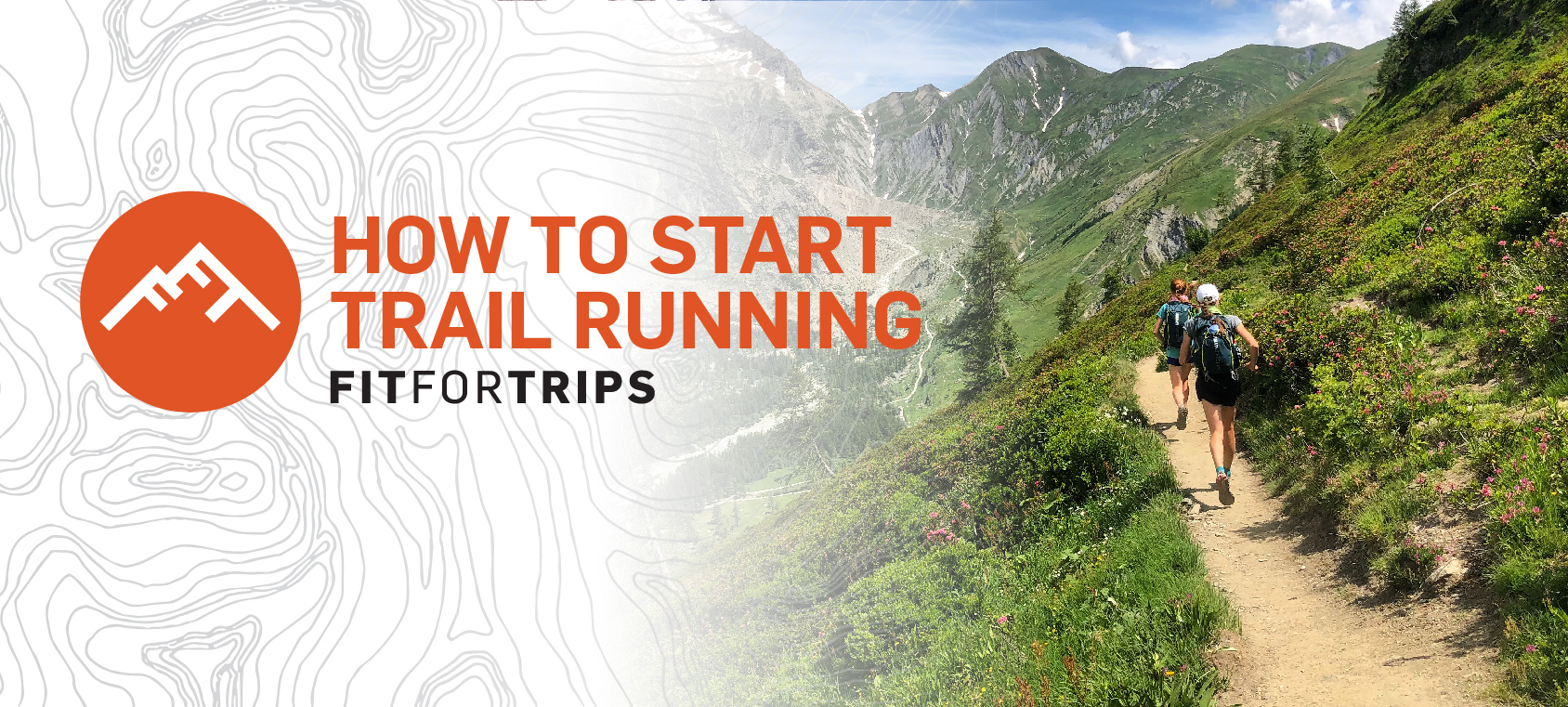
This is continuing education in our trail running series. Check out our 1st one Trail Running Tips For Beginners. One does not replace the other; read both.
The Fit For Trips team caught up with Liz Gill, founder of Runcation Travel, to hear about how she transitioned from a focus on cross country and track to running trails, and her best tips for how to start trail running. She answered all of the questions a new trail runner might have about how to train, pacing, what to wear, what to eat/drink, and whether or not trail runners walk.
After competing collegiately at the NCAA Division 1 level for Columbia University and the University of Southern California, Liz was looking for a new challenge. Today she coaches runners and operates an international adventure company for runners who want to experience a shift in perspective as they explore new destinations on foot.
 Liz Gill leading a trail running Runcation Travel trip in the Italian Dolomites.
Liz Gill leading a trail running Runcation Travel trip in the Italian Dolomites.
Why did you transition to trail running?
I grew up running in the Bay Area in Marin County. Miles of trails were accessible right from my home. I’d always use the trails to train when I was competing in track and cross country. It wasn’t really referred to as trail running at the time, it was just called running. After competing in high school and college I used trails to explore a different type of running. Coming out of collegiate running, I think you can experience a little burnout and injuries. I found very freeing to run on trails where pace truly doesn’t matter. So, I just really enjoyed running for running’s sake versus for competition.
What were the challenges switching from track and cross-country training to trail running?
I think one of the biggest challenges transitioning to trail running was coming from a sport where you never need to carry anything. In track and cross country, you don’t really pay attention to fueling or hydration. The idea of carrying a hydration pack and being out for hours instead of just an hour, was a challenge for me.
Insider tip: Think in terms of time spent on your feet instead of miles covered.
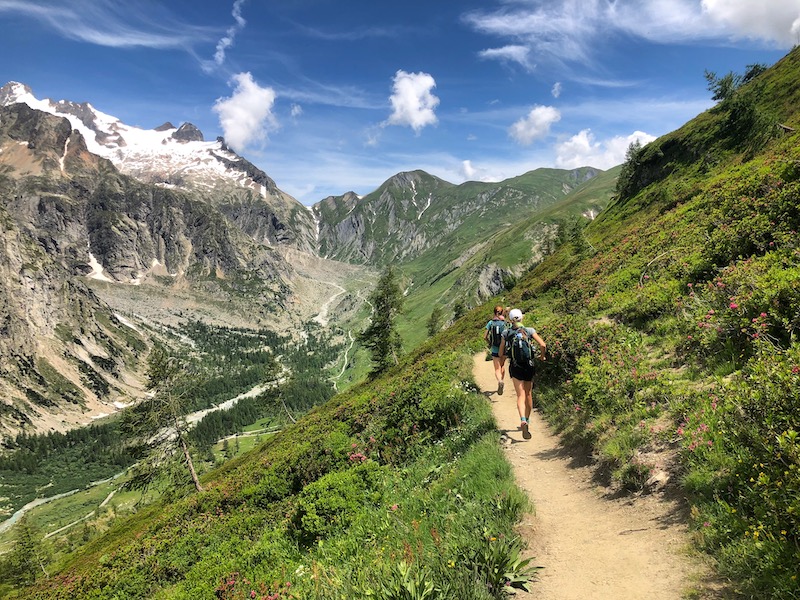 Tour du Mont Blanc trail running with Runcation Travel on singletrack in Courmayeur, Italy.
Tour du Mont Blanc trail running with Runcation Travel on singletrack in Courmayeur, Italy.
Changing my notion of time spent running instead of needing a certain number of miles helped me figure out how not to get super dehydrated on longer runs. It gave me a better sense of knowing which runs I had to take nutrition and hydration on. Additionally, reframing the whole idea of pacing and having to be more effort based was key.
Trails can be so different depending on where you are and which route you’re doing. With trail running, keeping an open mind is important, whereas track and cross country is very precise, specific, and calculated in terms of pacing and training.
How do beginners start trail running?
I would say for beginners, you should start trail running somewhere that has always interested you. So, if you’ve always been curious about a park or trail system by your house, start there.
I think a really good way to approach it is to use to free technologies to map out runs and get a sense of mileage and elevation. If you’ve been running on roads with zero elevation gain, I suggest planning something that’s 500 feet total elevation for a few miles to see how that goes, and go from there.
 Running in the High Sierra in Yosemite National Park. Photo credit is Tony DiPasquale.
Running in the High Sierra in Yosemite National Park. Photo credit is Tony DiPasquale.
It’s totally okay to keep in mind that walking is a part of trail running, and often, especially for beginners, whether they’re new to running in general or new to running on trails. I think a combination of walk/runs on hills can be really beneficial starting out to make it less daunting. You can build great fitness and experience and get your muscles used to the trails that way, and build up from there.
I think a lot of people are interested in starting trail running because there’s something about, maybe, seeing a new view or place, or seeing a photo of a trail and wanting to experience it firsthand. I think it’s good to find something that is intriguing to you or a place you want to explore and go from there.
Insider tip: AllTrails is a free app. Use the ‘Explore’ feature to find local trails filtering by difficulty, elevation gain, difficulty, and more.
Do trail runners really walk?
So, when people are asking, “Do trail runners walk?” I think they’ve had an experience on a hill that goes on forever, or a longer trail that feels never ending.
Insider tip: Yes – trail runners do walk.
If you look at any level of trail runner, from an elite athlete competing at a world mountain running championship, to a trail race in your local town, I think everyone is walking at some point.
 Liz Gill on a trail running Runcation Travel trip in Argentine Patagonia.
Liz Gill on a trail running Runcation Travel trip in Argentine Patagonia.
If the route has steep or long hills, or if the route itself is long, it’s more efficient to power walk the uphills. For beginner trail runners, that’s definitely something to play around with.
The idea of walking is a big shift from road and other types of running that people don’t seem to think is an option. It actually turns out it can make your running more efficient and allow you to go on a little longer on trail runs. It helps you save some energy for the entire run instead of just killing yourself trying to run up a hill all the way.
What kind of technology do you think will help a beginner’s confidence when running trails?
I think there are a lot of cool things with technology right now, for both confidence and safety, and also just logistics.
A lot of the GPS watches now will have a map to reference as you’re on the run. They also show mileage and pace.
Insider tip: Garmin hiking watches have GPS and map features that are perfect for runners.
 Checking out the route on a hut-to-hut guided Dolomites Runcation Travel tour.
Checking out the route on a hut-to-hut guided Dolomites Runcation Travel tour.
I always bring a phone with me on trail runs. For plotting and planning I use the FATMAP and Gaia apps a lot. There are plenty of apps like All Trails or Map My Run to use. Even Strava has features where you can plot out a route before and look at it after. FATMAP is also really great because it gives you an interactive, bird’s eye view of what your running route is all over the world.
Strava is super popular. It has a safety feature where you can alert people when you’re on a run, or share your location with people.
I think using technology can be helpful on trail runs, both in not getting lost or having a better sense of where you are, and from a safety perspective, also.
What gear do I need to start trail running?
If there’s one thing you need to be a trail runner, a good pair of shoes would be it. That’s a really crucial piece of gear because it makes a difference. There are so many choices across brands and models.
 Happy trail runners on a Runcation Travel guided tour in Patagonia, Argentina.
Happy trail runners on a Runcation Travel guided tour in Patagonia, Argentina.
What I always tell my coaching clients and people that are joining my trips is, one of the best things you can do is find a shoe brand that fits your foot. There is so much variety between people’s feet and how shoes fit, just across the board.
It’s definitely a worthwhile investment to get a pair of trail-specific shoes. There’s a lot of cool hybrid models out there if you’re running on a mix of roads and trails. There are also really heavy-duty trail shoes with rock plates for technical terrain. Also, there are shoes with lots of cushioning if you’re going to be out for hours.
Insider tip: Trail shoes are designed with thick and deep lugs on the soles to grip the terrain. This helps your confidence and surefootedness.
Depending on the terrain and where you’re running, like on rocks or loose sections of gravel or dirt, having traction will prevent you from slipping and can really help your confidence when you’re getting started with trail running.
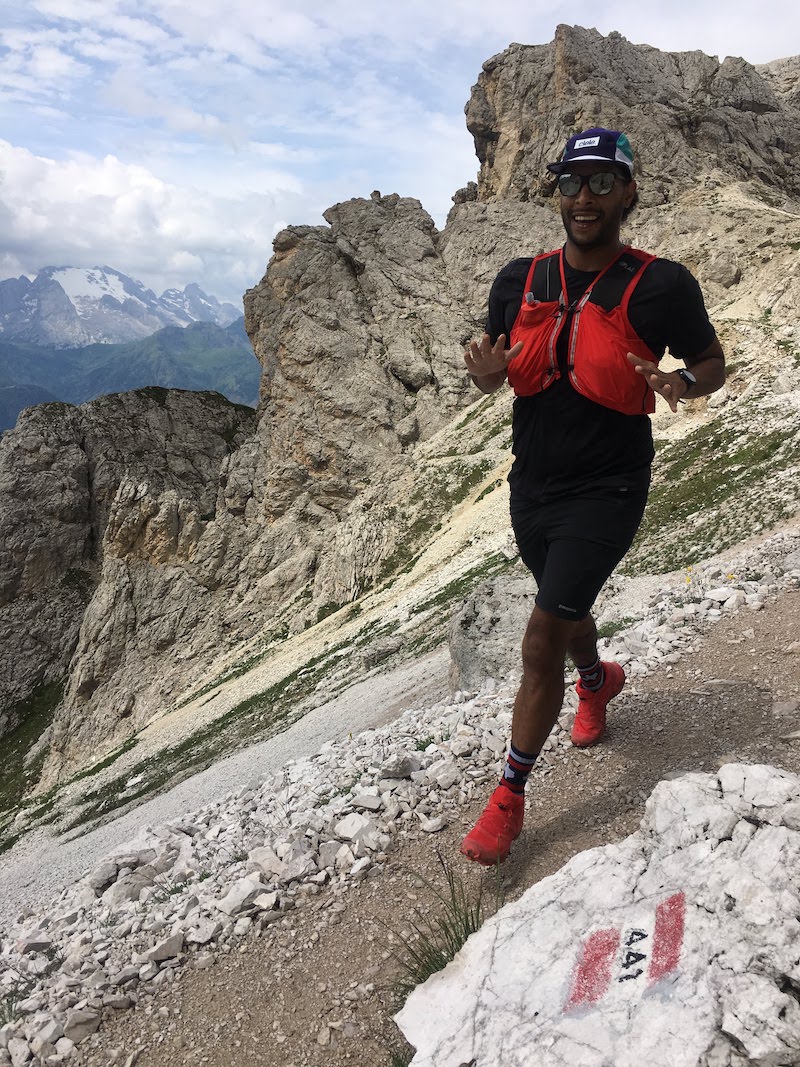 Runcation Travel group tour in the Italian Dolomites.
Runcation Travel group tour in the Italian Dolomites.
Other than shoes, just a pair of shorts and a t-shirt is basically all you need. If you end up liking it and getting to the point where you’re running longer, the next crucial item would be some sort of pack or hydration vest, and there are tons of options. Even a waist belt, just to carry some water, snacks, and phone with you, is a great option. ULTIMATE DIRECTION innovates every product you need for running except for shoes.
Starting out, I think you just need a really good pair of trail shoes. They need to fit well and work for the terrain and distance you’re running. All the other gear is stuff you can easily add on later.
How many days a week should a beginner trail run?
Realistically, it’s based on where someone’s training level is currently and what their goal is.
If a new runner’s goal is just to get out on trails more often, or if they’re trying to eventually do longer distances, like an ultra, the answer would be totally different.
Insider tip: Always start out moderately. Running trails is going to work your body differently than hiking or running roads will. It’s best to start with fewer days to build up confidence and endurance. Then add days as your body adjusts and you get more comfortable.
If you can get out, aim for two days a week. If you’re doing some supplemental cross training, then maybe aim for two to three days of trail running per week and then work up from there.
 Trail Running in Argentine Patagonia, El Chaltén.
Trail Running in Argentine Patagonia, El Chaltén.
I think six days is like probably the maximum I would recommend for a sustainable trail running experience, over time. At the lower end of it, you can notice the difference with two to three days of trail running. Even if you’re starting out with 20 to 30 minutes of run/walking, and then building up to 20 or 30 minutes of trail running.
Insider tip: Use the 10% guide for adding mileage.
A good principle for building mileage is not to add more than 10% to your mileage every week. This won’t be linear, but is a good rule of thumb when building up your mileage and running routine. The effort adding miles is cumulative over time. Ultimately, you get to a point where you want to drop down or give yourself lighter mileage to recover. A good rule of thumb is to train in four-week cycles that include an increase in mileage with a break between cycles for recovery.
What’s a good pace for new trail runners?
I think a good running pace is where you’re keeping a consistent effort throughout. You could be going slower on the uphills, faster on the downhills, and somewhere in between on the flat sections.
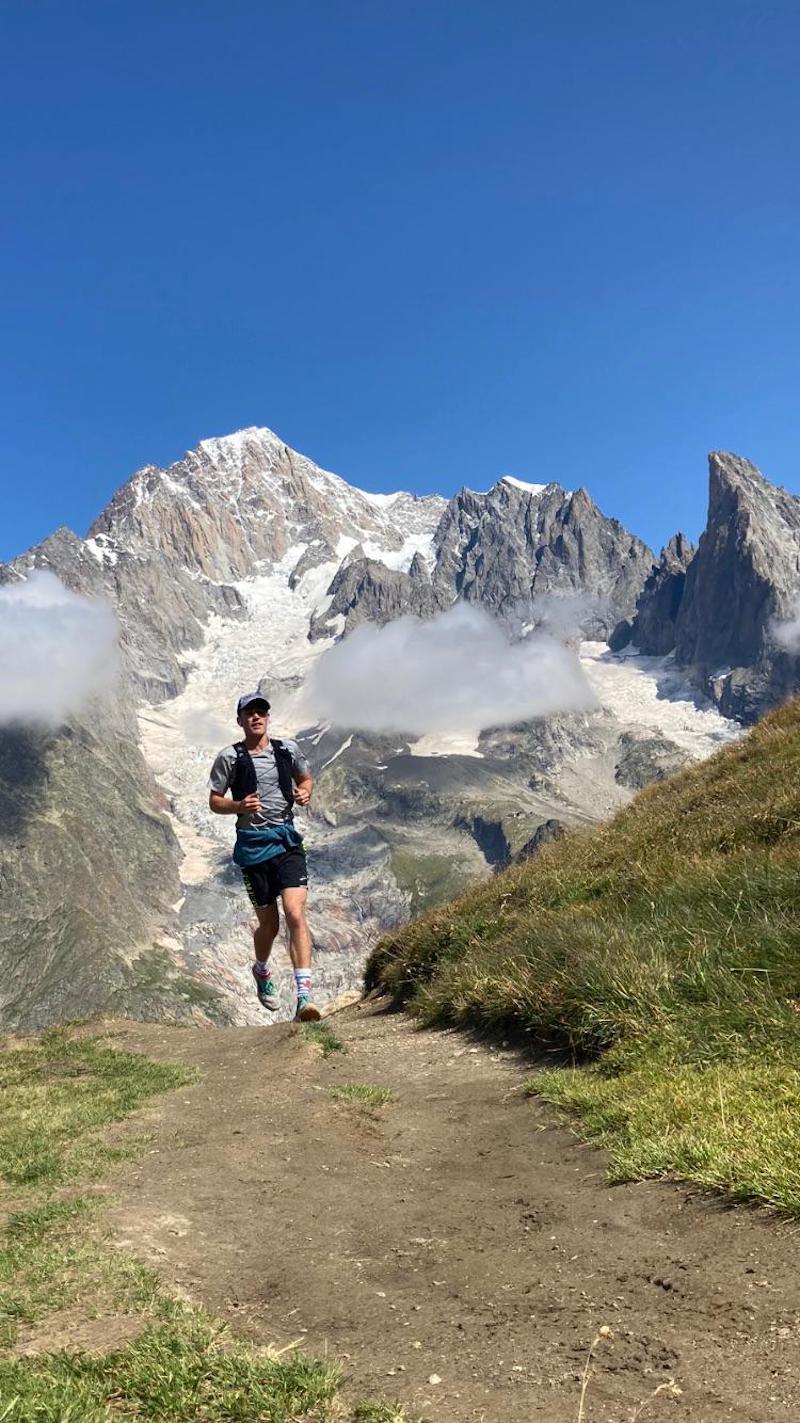 Trail runner on a self-guided Tour du Mont Blanc Runcation Travel summer trip this.
Trail runner on a self-guided Tour du Mont Blanc Runcation Travel summer trip this.
If you’re gaining 1000 feet of elevation in a mile, your pace is probably going to be 20 minutes or more for the miles, and that’s totally fine. It could be faster if you’re running down that.
Insider tip: Pacing for trail running is dependent on how runnable the terrain is and the steepness of the incline.
I think instead of focusing on your pace, it’s good to keep more of a consistent effort throughout. Some people use heart rate training and monitor with a watch. Or, you can monitor effort based on your breathing and perceived effort, or how you’re feeling.
When starting out with trail running, especially for those of you who run roads already, I would not have your watch on pace. Stay away from checking that too often. I’d recommend going more by feel when you’re starting out.
What kind of terrain do you recommend for trail running?
I recommend trying out different types of terrain and seeing what suits you. I think one cool thing about trying is there’s such a huge variety of what can be considered trail running.
 Trail running Runcation Travel tour in the Dolomites.
Trail running Runcation Travel tour in the Dolomites.
You can be running on fire roads, which are kind of like wide, dirt roads that have really good footing. Or you can run in the Sierra where granite rocks are everywhere and the trail is quite technical and rocky.
Insider tip: Different strokes for different folks. Explore different types of trails to help you choose the style you enjoy running the most. The stuff you enjoy running on is something you’re more likely to keep coming back to.
So, I would just say get on some single track; get up some fire roads; get on rocky, steep things and technical things with roots; and then also flat, easier, runnable terrain, and just see what you like and prefer.
If you have a goal, like a technical alpine setting in mountains or a longer race, I think it is better to get on more technical terrain because that’s going to challenge how you’re running and teach you how to handle those types of trails over a long period of time.
Alternatively, if you want to get faster on trails or if you want to do a race that’s quite runnable and less technical, then it’s probably better for you to run on trails where you can keep a consistent pace, such as rolling roads or flat dirt trails.
Either way, training on the terrain that your goal involves is only going to help you.
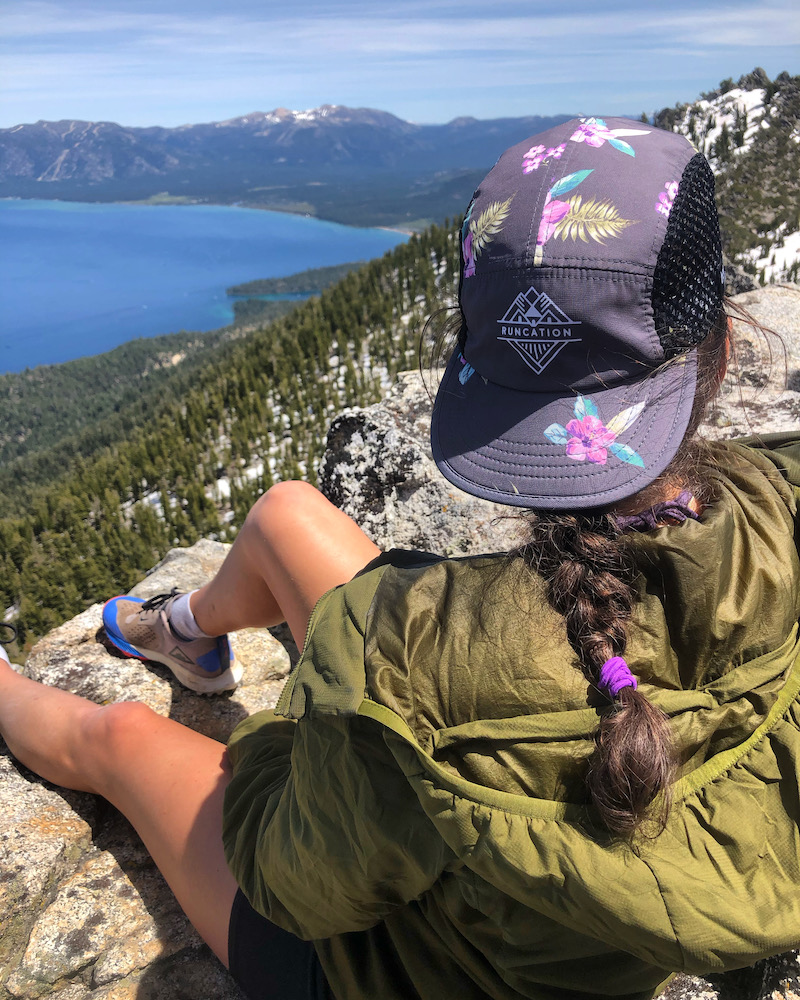 Runcation traveler chilling in Lake Tahoe.
Runcation traveler chilling in Lake Tahoe.
What tips do you have to avoid injury?
It’s much better to do a little less starting out than overdo it. As with all running, it’s better to be under trained than over trained.
I think it’s really easy to go out a little too aggressively when starting a new type of running, trails or not. It can set you back further than just if you were to dial it back a little bit. That first month or two is a crucial period for letting your body adjust to the new activity.
You will use so many different types of muscles in trail running that you don’t use in other types of running. So, just let your body adapt to the different types of impact and muscles you’re using on trails, and also get used to the footing so you’re not rolling your ankle off the bat. It helps to choose less technical trails to start.
Insider tip: Explore nutrition and hydration strategies.
The trail running experience is much more pleasant when you’re not dehydrated, especially for runs 60 to 90 minutes or longer. Try different things to see what works for you.
Insider tip: Spread out your mileage during the week.
It’s easy to kind of stack everything on the weekends and not do so much during the week. If you’re training for longer trail runs, it helps to spread the mileage out over the week instead. This prevents having a drastic shift between weekdays and weekends.
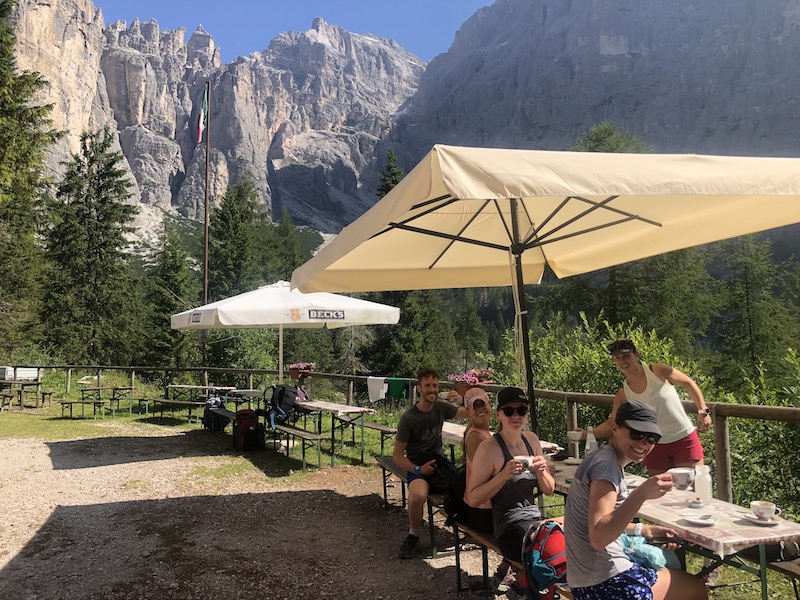 Cappuccino break on a guided Dolomites Runcation Travel trip.
Cappuccino break on a guided Dolomites Runcation Travel trip.
Should you size up for trail running shoes?
This depends on the brand. Overall, I think you do want more room, especially in the toe box of the shoe. Feet definitely do swell, especially on longer runs and hotter days.
Insider tip: Companies like Xero Shoes sell products with a very wide toe box. They intentionally minimize support and cushion, which they purport is beneficial and many athletes have made the switch. Just be sure you make an informed choice.
It’s not going to hurt you to have a little more room, but it could hurt you if the shoe is too small. When you’re running long or on the downhill, you can really notice things that you wouldn’t necessarily notice if you were just walking around a running store in that shoe.
Overall, it’d be a good rule of thumb to size up, but also look into the shoe company and various models to see if a shoe tends to run large or small.
 Trail runner on a self-guided Tour du Mont Blanc Runcation Travel summer trip.
Trail runner on a self-guided Tour du Mont Blanc Runcation Travel summer trip.
What kind of clothing do trail runners wear?
You feel more comfortable wearing material that’s wicking and fast drying. It’s best to avoid things like cotton because it doesn’t dry quickly and it chafes.
Insider tip: Familiarize yourself with the conditions you’ll be running in and plan accordingly. If you know you start out cold but warm up quickly, plan to start with a light layer that you can tie around your waist. When you’re headed into higher elevations where it’s cooler and the weather can change quickly, bring appropriate layers for cold, wet, and windy weather.
If you’re running on a 70-degree day in the low country or where you know it’s going to be that same weather the whole time, a tank top or a t-shirt and shorts are really all you need.
When you’re going to be up at higher elevations, even if it’s a beautiful day, I think it’s always good to have layers with you. You never know if there’s going to be crazy wind, or a rainstorm or hailstorm. Packing layers is pretty necessary for some of those longer or more adventurous runs.
Going back to kind of the same thing with shoes, it helps to find clothes that are comfortable, that you don’t really notice.
Why do trail runners wear long socks?
That’s a good question. One of the things that people could be wondering about are the longer compression socks. There are a few brands, like CEP, that have compression materials in the socks to help with blood flow. As you’re running longer your blood pools, and circulation in your extremities becomes more difficult. The socks help circulate blood back out of your calves to the rest of your body to prevent swelling. Some people really love the feel of them. I’m not sure, scientifically, what the data is on that, but that could be one reason people are wearing longer socks.
Also, when you want to wear shorts instead of pants, longer socks can be helpful if you’re running through brush. On some trails there will be things scratching at you, so taller socks offer protection from the brush that you’re running by.
How do you break in trail running shoes?
One way you break in trail running shoes is just to go out and run.
Insider tip: When testing out new trail running shoes, go short.
Don’t choose one of your longest runs as the day to break in new shoes. Pick a shorter, midweek run. See how they feel before you use them for a hard effort, race, or a long run. Basically, avoid runs when there’s more at stake.
Most shoes out of the box are pretty comfortable these days. It’s not like some other sports where you really need to break them in. Making sure that there are no hot spots that can lead to blisters, pain, or other things happening to your feet can be really important.
What should you have in your pack when you trail run?
At minimum, you should have snacks and sports nutrition, or whatever your favorite fuel is.
Water is definitely important. Some people will add electrolyte mix or salt tablets, or other things like that, but at the very minimum, water. If you’re running for several hours and won’t be able to carry all the water you need with you, a lightweight, portable water filter is also super helpful for long trail runs where you can refill using natural sources of lakes or streams.
Insider tip: Experiment with different electrolyte drinks and mixes to see what your stomach can tolerate when bouncing around and during exertion.
Some sort of communication device is important, whether it’s like your phone or if you’re away from service, you can use things like GPS and satellite devices like Garmin inReach. They have a Garmin inReach Mini now which lets you send out messages when you’re in places without service.
I always bring a first aid kit. Your first aid kit can be basic or built out. It helps to include things such as bandages, Advil, and Benadryl. If you get stung by a bee or twist your ankle, having first aid is helpful. It will get you back to the car or fixed up until you can get help. There are tons of cool blogs out there detailing types of first aid kits that you can use for inspiration for minimalist and lightweight kits.
Then there’s layers. Like I said before, even if it’s a warm, beautiful day, I always like to pack some sort of lightweight rain jacket. You never know what can happen either with weather or, say, if you get lost and it takes way longer than you think. I really like the Patagonia Houdini jacket because it just packs up really light. If you don’t want to buy anything, you could throw in an emergency blanket or trash bag because they’re super lightweight.
Why did you start a trail running adventure travel company?
After competing collegiately, I got into coaching and guiding and exploring trails when I traveled. With trail running, I liked being out in nature and seeing new places. As I traveled for work, and other things, I basically used running to explore new places. I’ve been coaching at the high school, collegiate, and adult levels since 2009. I combined these experiences and skills to build an adventure travel business for runners.
 Owner and founder of Runcation Travel company, Liz Gill.
Owner and founder of Runcation Travel company, Liz Gill.
What kind of shape do I need to be in for a trail running trip?
This is going to be different based on where someone’s coming from, geographically. For example, I had someone from the Netherlands come on the Dolomites trip. I think the hilliest place near him was a hill that was 300 feet high. To prepare for the Dolomites he would just do hill repeats on that hill. He actually found on the trip that he was a really natural hill and trail runner.
Insider tip: You don’t have to train on terrain identical to your trip. Get creative.
If you can, introduce some level of trails or hills to your training. I would just say, one large difference that people notice on these trail running trips versus their regular running for a week at home would be the back-to-back days on trails.
If you’re joining a trip that has a lot of elevation gain and loss over the course of a week, it’s good to prepare doing some back-to-back runs. Maybe i’ts not all on trails or the same elevation gain or loss. Just getting your body ready for a few back-to-back days where a pace isn’t super important, is important. Even if it’s a combination of walking and running.
I also think training the downhill is kind of better to train than the uphill. Many people aren’t used to that amount of elevation descent per day. Especially if they’re coming from flat roads.
Insider tip: Training on an aerobic step by stepping up quickly and back down helps muscles tolerate downhill. Videos in this article perfectly demonstrate aerobic step techniques you can mimic.
There are a lot of things you can do, either in a gym or even an outdoor setting, to prepare. A simple step up on a bench or stairs, or plyometrics, helps get your quads used to the eccentric contraction that happens when you run downhills. It’s helpful to build up some of those muscles to support the impact of descents, even if you’re not able to kind of mimic that on outdoor trail running before a trip.
The most important thing, fitness wise, before joining a trip is to prepare your body for the itinerary you’re selecting. It’s not so much about pace or doing intense workouts. It’s more just having your body a more durable to be able to do trails for a few days in a row.
What is the biggest surprise for people who join one of your trail running trips?
I think the number one thing is training for those downhills, like I mentioned before.
Insider tip: You can substitute or supplement hilly terrain with walking up and, most importantly, down stairs to train your quads to tolerate the stress of downhill running. You can also run in parking garages to simulate hills.
With elevation gain and long climbs, we’re walking a lot of it. If you’re aerobically doing some running, it’s something your body can adapt to easier. But people see elevation gain on a trip and don’t think about the fact that you have to go down. I think people forget the impact of descents, and the soreness that you’ll feel if you’re not building up those muscles to prepare.
It can sneak up on you. I know I experienced it for the first time this year, not running year-round. I was doing more backcountry skiing in the winter. Doing activities like that helps you get in great shape aerobically, but then the first long downhill you have on foot after that, your quads are shaking by the end because they’re just not ready for that impact.
I think training for the descent is critical to ensure you can recover from downhill running stress on the body. This could be running downhill or incorporating eccentric quad work into the training you’re doing.
How is the experience different on a trail running trip versus a hiking trip?
With running you can obviously cover more ground. You’re seeing a lot more, and also, you can make it long days or shorter days.
On our trail running trips you’re carrying less, just what you need for the day, because your baggage is transported. On a backpacking trip you’re carrying all of your belongings. So, things tend to feel easier and lighter, and that’s helping you cover more ground and see more places.
I think it also is a different experience in terms of the different places and the type of terrain. Trail running opens your eyes to different types of trails and how to run them.
Any anecdotes from your trips about a client or clients that had a life changing experience?
I’ve received some great testimonials from the feedback reports I send out after a trip. Many people have said things like, “That was like life changing,” and, “That was one of the best trips of my life.”
If you love to run, I think having a trip totally dedicated to seeing a place that way is a really cool experience. Combining that with like-minded people can be cool, to just bond and meet different types of runners from different places.
If someone’s never had that experience as a trail runner, maybe they’re new to it from road running, going on a trip has opened their eyes to get more into trail running, whether it’s competing in racing or just adding that into their life.
A lot of people find that they like it more than they anticipated. Or that it’s not as quite as intimidating as it was before the start of the trip. It can be a really cool change in people’s lives and how they incorporate it into their daily running afterwards. I think running in beautiful places and out in nature on trails has so many benefits to improve people’s lives. It’s exciting to see people experience that on trips and start to seek that out more after returning home.
